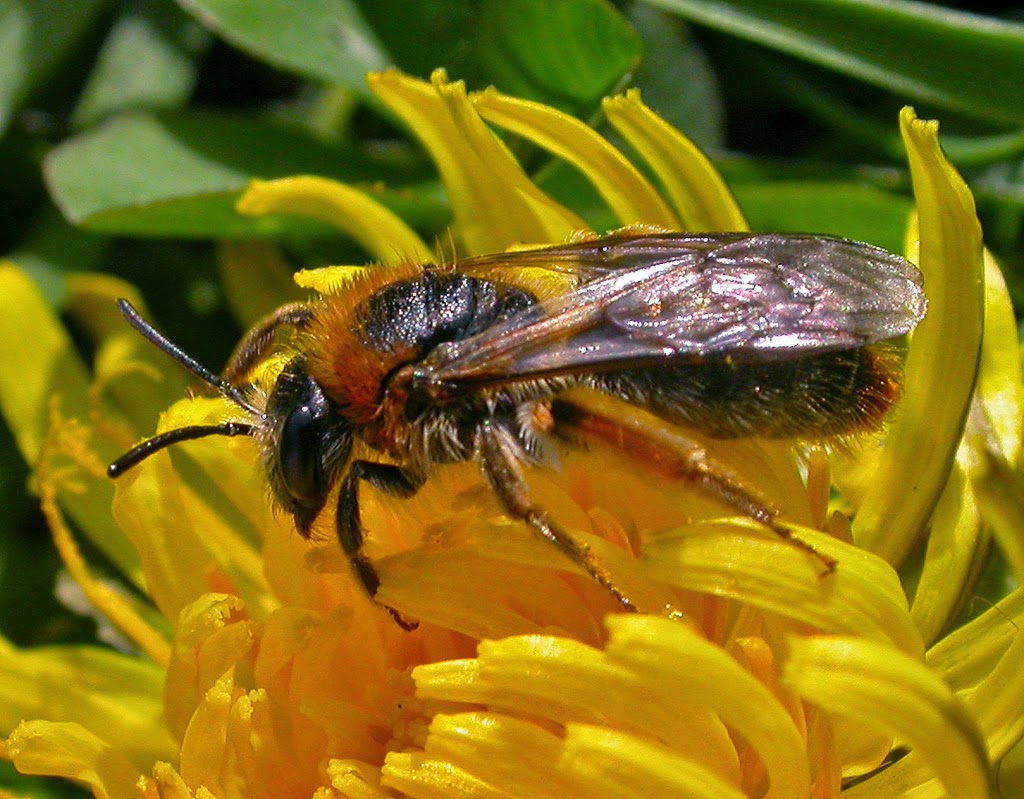Miner Bees were @SpeciesofUK from 17th
to 23rd March, 2014.
‘Miner bees’ or ‘sand bees’ make up the genus Andrena. There are over 1,300 species worldwide of which around
sixty live in the UK, making it one of the largest bee genera.[1]
 |
| Miner Bee [Wikimedia Commons © Jeffdelonge] |
Miner bees get their name from their habit of digging nest burrows in
sandy soil, in which their prepupae spend the winter.[2]
One of our most common miner bees is
the ‘tawny miner bee,’ Andrena fulva.
The tawny miner bee is found across most of Europe, as far south and east as the Balkans.[3]
It likes light woodland or dry grassland, with sandy soil for its nests. Grassy parks and gardens suit it down to the ground.[4]
 |
| Tawny Miner Bee [Flickr Creative Commons © mausboam] |
In March, tawny miner bees will emerge and visit any flower that's
available. By May, they have become the key pollinators for many current bushes
and fruit trees.[5]
The female tawny miner bee is very
colourful.
Her thorax is covered in rich russet hair and abdomen banded in burnt
orange.[6]
 |
| Female Tawny Miner Bee [Flickr Creative Commons © Nigel Jones] |
Male tawny miner bees are less bright and are more tawny in colour. They
have a paler abdomen, white hair on the face and are smaller and slimmer.[7]
 |
| Male Tawny Miner Bee [Flickr Creative Commons © Sarah] |
 |
| Male Tawny Miner Bee [Flickr Creative Commons © Nigel Jones] |
Male tawny miner bees play no part in
nest building or providing for their offspring.[8]
All the hard work is done by the female. She works on her own to build a
nest and collect pollen for the young to feed on.[9]
The tawny miner bee nest or 'mine' will be in areas of sandy soil and on
the surface looks like a volcano-shaped mound of excavated material with a
pencil-sized hole in the middle.[10]
 |
| Tawny Miner Bee Nest [Flickr Creative Commons © Sarah] |
Tawny miner bees are solitary and rarely form colonies. However, their
nests can be in close proximity. There can be hundreds of nests within a few
metres of each other.[11]
Inside, the tawny miner bee nest is a 20-30cm vertical shaft with brood
cells each filled with one egg in a nectar and pollen mixture branching off it.[12]
Female tawny miner bees solidify the nest entrance with a fluid while
they're laying the eggs. When they're finished, they plug it shut completely.[13]
 |
| Female Tawny Miner Bee building Nest [Flickr Creative Commons © Sarah] |
Tawny miner bee larvae hatch after a few days and grow quickly, pupating
in a few weeks. After hibernating in the nest through winter, adults emerge in the
spring.[14]
 |
| Tawny Miner Bee Emerging from Nest [Flickr Creative Commons © bramblejungle] |
Another miner bee found in the UK is Andrena nigroaenea.
 |
| Andrena nigroaenea [Flickr Creative Commons © Nigel Jones] |
A. nigroaenea are solitary
ground nesting bees like the tawny miner bee, but less common. They're also
rather plump in appearance.[15]
The female A. nigroaenea
emits a very strong pheromone to attract males. Once she’s been
inseminated, she then emits a different pheremone, which deters the males![16]
Interestingly, there’s an orchid called the early spider orchid (quite
rare in the UK) that emits a pheromone identical to that of A. nigroaenea females. The males can’t
resist it and therefore visit the plants, pollinating them.[17]
 |
| Early Spider Orchid [Flickr Creative Commons © gianky55] |
A. nigroaenea is perhaps best
known as the unfortunate victim of a parasite - the cuckoo bee, Nomada goodeniana.[18]
The cuckoo bee enters unguarded nests of A. nigroaenea and lays an egg in one of the brood cells. It either
removes the original egg, or its own larva destroys it.[19]
 |
| Cuckoo Bee [Flickr Creative Commons © Hamish Irvine] |
Here is a small selection of some of the UK’s other
miner bees.
This is Andrena cineraria,
the so-called ‘ashy miner bee.’
 |
| Ashy Miner Bee [Flickr Creative Commons © gailhampshire] |
Ashy miner bees are fairly common throughout the UK, although less so in
Scotland. They usually fly from April to June.[20]
They are very distinctive, being mostly black with two bands of white
hair at the front and back of the thorax, and a tuft of white hair at the front
of the head.[21]
 |
| Ashy Miner Bee [Flickr Creative Commons © Jürgen Mangelsdorf] |
Then there's the 'early miner bee' A.
haemorrhoa, which is one of the first miner bees to appears, between March
and April.[22]
 |
| Early Miner Bee [Flickr Creative Commons © Jamie McMillan] |
And here is A. carantonica, a
miner bee which shares nest entrances so lives partially communally.[23]
 |
| Andrena carantonica [Flickr Creative Commons © Laurence Livermore] |
Because the nest chambers of A.
carantonica share an exit, fresh adults meet on the way out, mating
immediately on emergence.[24]
Strange but true…
It is relatively easy to stand on a tawny miner bee by accident because
of their habit of nesting on the ground. But don’t worry, their 'sting' is
extremely weak and unlikely to penetrate bare feet.[25]
[1] http://www.bugsandweeds.co.uk/bees.html;
http://en.m.wikipedia.org/wiki/Andrena
[2] http://en.m.wikipedia.org/wiki/Andrena
[3] http://en.m.wikipedia.org/wiki/Tawny_mining_bee
[4] http://en.m.wikipedia.org/wiki/Tawny_mining_bee
[5] http://www.bugsandweeds.co.uk/bees.html
[6] http://www.bugsandweeds.co.uk/bees.html
[7] http://www.bugsandweeds.co.uk/bees.html
[8] http://www.buglife.org.uk/bugs-and-habitats/tawny-mining-bee#sthash.dRmlJqEZ.dpuf
[9]
http://www.buglife.org.uk/bugs-and-habitats/tawny-mining-bee#sthash.dRmlJqEZ.dpuf
[10] http://www.bugsandweeds.co.uk/bees.html
[11] http://en.m.wikipedia.org/wiki/Tawny_mining_bee;
http://www.bugsandweeds.co.uk/bees.html
[12] http://en.m.wikipedia.org/wiki/Tawny_mining_bee;
http://www.bugsandweeds.co.uk/bees.html
[13] http://www.bugsandweeds.co.uk/bees.html
[14] http://en.m.wikipedia.org/wiki/Tawny_mining_bee
[20] http://en.wikipedia.org/wiki/Ashy_mining_bee
[22] http://natureofdorset.blogspot.co.uk/2011/03/mining-bee-andrena-haemorrhoa.html
[23] http://www.gardensafari.net/en_picpages/andrena_carantonica.htm
[24] http://www.gardensafari.net/en_picpages/andrena_carantonica.htm
[25] http://www.bugsandweeds.co.uk/bees.html
When does mating happen? I have tens of miner bees, possibly from the description on this site all male, that have been flying around my developing wildflower meadow for about a fortnight
ReplyDeleteYour the beest
ReplyDelete